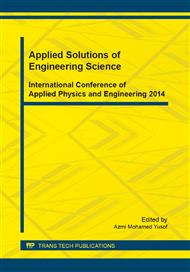[1]
N. L. Iskandar, N. A. I. M. Zainudin and S. G. Tan, Tolerance and Biosorption of Copper (Cu) and Lead (Pb) by Filamentous Fungi Isolated from a Freshwater Ecosystem, J Environ Sci, 23(5), 2011, 824-830.
DOI: 10.1016/s1001-0742(10)60475-5
Google Scholar
[2]
F. Senusi, N.S.H. Ramlan, R. Alrozi, J. Krishnan, Equilibrium and kinetic studies on removal of cadmium ion by using immobilized Saccharomyces Cerevisiae. In proceedings of IEEE Symposium on Humanities, Science and Engineering Research (SHUSER 2013), Penang, Malaysia, June 23-25, 2013, pp.503-507.
Google Scholar
[3]
B. Kiran, and A. Kaushik, Equilibrium sorption study of Cr (VI) from multimetal systems in aqueous solutions by Lyngbya putealis, Ecological Engineering 38 (2012) p.93–96.
DOI: 10.1016/j.ecoleng.2011.11.001
Google Scholar
[4]
M. Gohari, S.N. Hosseini, S. Sharifniaa and M. Khatami, Enhancement of metal ion adsorption capacity of Saccharomyces cerevisiae's cells by using disruption method, Journal of the Taiwan Institute of Chemical Engineers 44 (2013) p.637–645.
DOI: 10.1016/j.jtice.2013.01.002
Google Scholar
[5]
J. P. Cazón, C. Bernardelli, M. Viera ,E. Donati, and E. Guibal, Zinc and cadmium biosorption by untreated and calcium-treated Macrocystis pyrifera in a batch system, Bioresource Technology, 116 (2012), p.195–203.
DOI: 10.1016/j.biortech.2012.04.014
Google Scholar
[6]
T. Akar, Y. Y. Balk, O. Tunaa, and S. T. Akar, Characterization and Application of Plant-Based Magnetic Biomaterial for Batch and Fixed-Bed Mode Sequestration of Lead from Synthetic and Real Effluents, Ecol Eng, 61, 2013, 251-257.
DOI: 10.1016/j.ecoleng.2013.09.062
Google Scholar
[7]
F. Pagnanelli , M. Trifoni, F. Beolchini, A. Esposito , L. Toro, F. Veglio, Equilibrium biosorption studies in single and multi-metal systems, Process Biochemistry, 37 (2001), p.115–124.
DOI: 10.1016/s0032-9592(01)00180-7
Google Scholar
[8]
K.K. Wong, et. al, Removal of Cu and Pb by tartaric acid modified rice husk from aqueous solutions, Hemosphere, 50(1) (2003), pp.23-28.
DOI: 10.1016/s0045-6535(02)00598-2
Google Scholar
[9]
P.S. Kumar, and K. Kirthika, Equilibrium and kinetic study of adsorption of Nickel from aqueous solution onto bael Tree leaf powder, Journal of Engineering Science and Technology, 4(4), (2009), pp.351-383.
Google Scholar
[10]
S. Singh, B.N. Rai, and L.C. Rai, Ni(II) and Cr(VI) sorption kinetics by Microcystis in single and multimetallic system, Process Biochem., 36, (2001), pp.1205-1213.
DOI: 10.1016/s0032-9592(01)00160-1
Google Scholar
[11]
Y. Tian, et. al, Preparation and characterization of baker's yeast modified by nano-Fe3O4: Application of biosorption of methyl violet in aqueous solution, Chemical Engineering Journal, 165(2), (2010), pp.474-481.
DOI: 10.1016/j.cej.2010.09.037
Google Scholar
[12]
G.C. Panda, S.K. Das, A.K. Guha, Biosorption of cadmium and nickel by functionalized husk of Lathyrus sativus, Colloids Surf., B, 62(2) (2008), pp.173-179.
DOI: 10.1016/j.colsurfb.2007.09.034
Google Scholar


